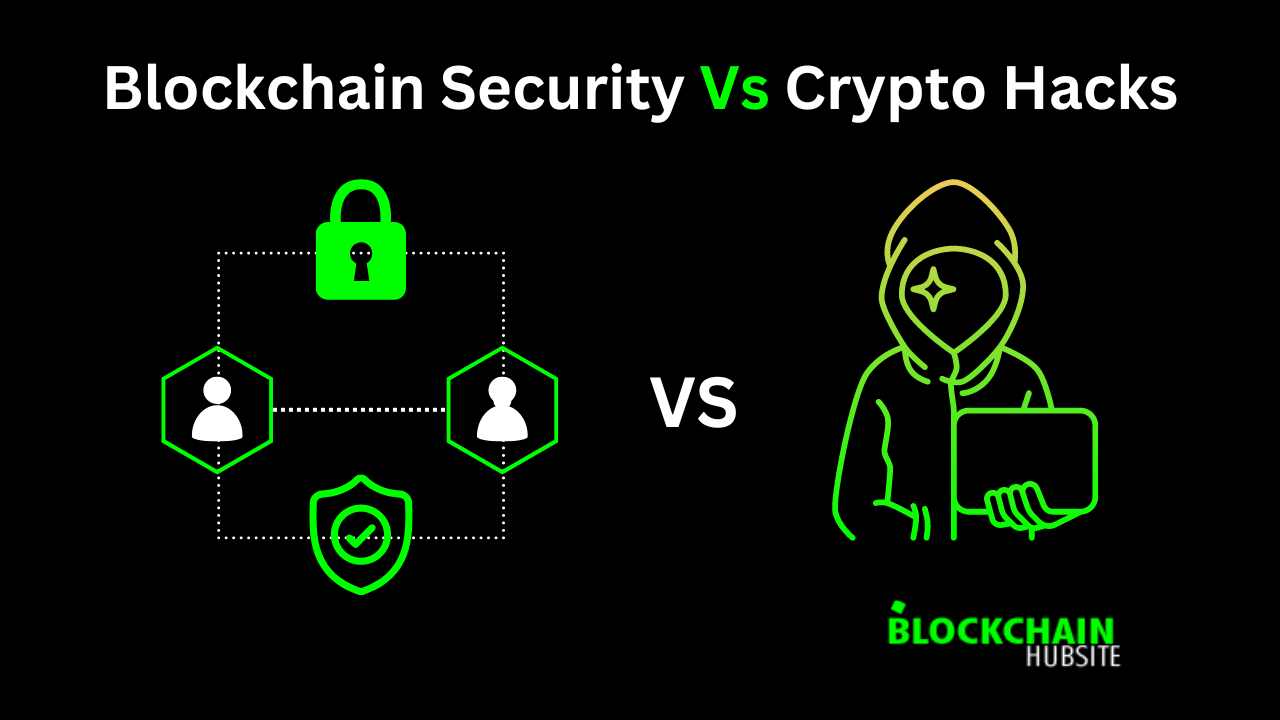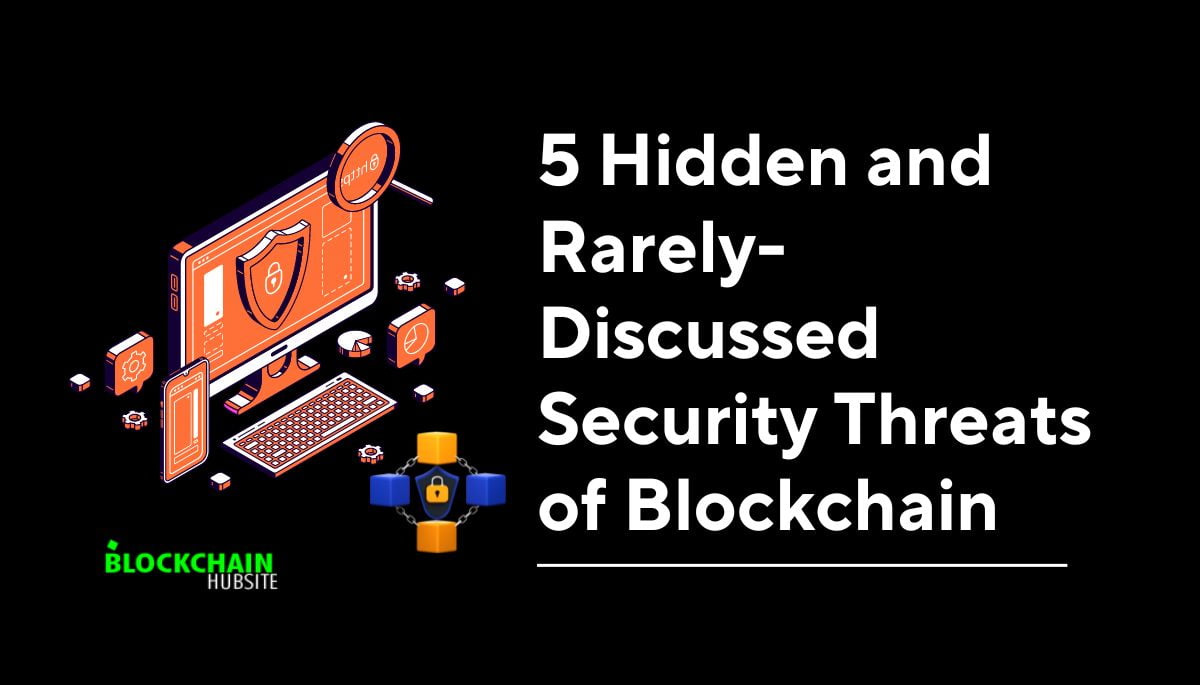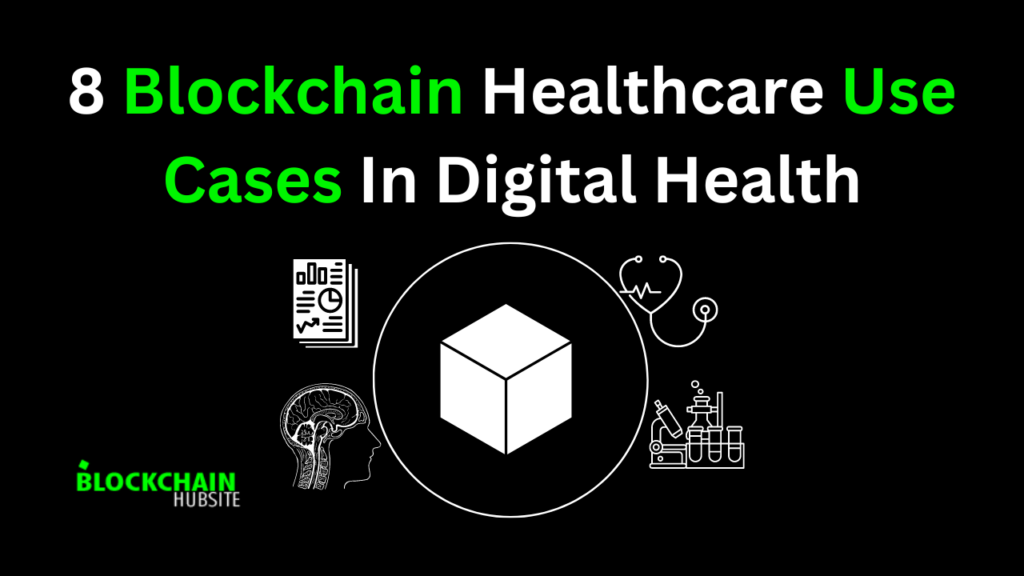
Table of Contents
For the majority of cryptocurrencies, blockchain technology acts as a foundation. Companies are now developing blockchain-based applications for their customers using blockchain technology to manage distributed databases, digital transactions, and healthcare. Because of its cryptographic, decentralized, and consensus rules, blockchain technology ensures transaction security.
Blockchain, however, is vulnerable to cyberattacks. For instance, Halborn disclosed a serious vulnerability that affected many of the top cryptocurrency wallets, including MetaMask, in June 2022.
Before deciding to employ blockchain technology, it is essential to understand how this new technology is secure and how one can still hack it.
Blockchain: Secure by Design

Multiple built-in security features in blockchain technology make it challenging for hackers to corrupt. A crypto hacker may be able to take control of a blockchain, but they are more likely to be able to steal tokens from wallets or exchanges.
How come to a blockchain is so difficult to attack? Blockchains have no single point of failure since they run. Cryptocurrencies also use public ledgers, advanced encryption techniques, and consensus mechanisms to increase security.
Every transaction is visible to the public on blockchains, such as Bitcoin (BTC). In actuality, every person who wishes to run a node on the Bitcoin blockchain must download the complete history of Bitcoin transactions. Because of this high level of transparency, malicious actions are less likely to send invalid transactions.
Participants in a blockchain can confirm transactions without the assistance of a third party, thanks to consensus mechanisms like proof-of-work (PoW) and proof-of-stake (PoS). PoW requires computers to solve complex algorithmic puzzles to verify new transactions on the blockchain. While in PoS, validators must lock cryptocurrency on the blockchain to approve a new transaction.
People who mine or stake in blockchains are motivated to follow the rules. Validators and miners are only rewarded with tokens if they complete their tasks. A validator’s crypto may be “slashed” by many PoS chains if the network identifies an invalid transaction.
Someone would need sufficient computing power to control half of the network to corrupt a PoW chain. A hacker would have to stake more than half of the total stake pool in the case of PoS.
So while it is possible to hack a blockchain, it is unlikely to happen on large-scale networks like Bitcoin or Ethereum (ETH). A cryptocurrency hacker would target smaller altcoin projects if they were to corrupt a blockchain.
What is a 51% attack?
Remember that to alter the transaction history, a hacker must control more than half of a blockchain. This type of crypto hack is known as a 51% attack. The most effective 51% attacks in the history of cryptocurrency happened on small- or mid-cap blockchains. For instance, hackers acquired 51% of Ethereum Classic’s (ETC) mining power at least thrice in 2020. The hackers manipulated data on thousands of ETC blocks and stole millions of dollars. Because taking over the network with a minor blockchain costs less, these 51% attacks are only possible on smaller blockchains. It would cost billions of dollars in hardware and electricity to stabilize a sustained 51% attack due to the size of the Bitcoin network.
The Cryptocurrency Security Paradox

The “cryptocurrency security paradox” concept explains how decentralized digital currencies like Bitcoin and Ethereum are still subject to various security risks despite being designed to be secure.
Before we get into the paradox, consider the following facts:
- The estimated value of all cryptocurrencies is over $3 trillion, greater than the market capitalization of huge companies like Apple and Microsoft and greater than the GDP of many countries.
- The biggest cryptocurrency market is the United States, followed by Nigeria.
- India has over 100 million investors and has the most cryptocurrency investors overall. The number of cryptocurrency investors in the United States is around 27 million. There are over 13 million cryptocurrency investors in Nigeria. According to Crunchbase data, there have been 5059 companies founded in the cryptocurrency space, of which 4,654 are for profit.
The biggest paradox nations face is how to control cryptocurrency, which has more than 300 million users worldwide. Here are some of the problems that cryptocurrencies cause for the country:
- Cryptocurrency is under external control. In other words, it lacks the influence of any particular government and is “demoralized.” When an investor invests in a cryptocurrency, the local currency is converted into cryptocurrency, causing it to leave the local financial system. This external control becomes a problem for countries with highly volatile currencies against the US Dollar.
- If cryptocurrency mining in a country is not keeping up with demand, money may flow elsewhere, which could cause a severe mid-term Balance of Payments problem.
- The price of cryptocurrencies is more volatile than any other investment option available to investors.
- Since the investments are untraceable, they have developed into essential tools for terrorists and fraudsters. Governments all over the world are under intense pressure to stop these activities.
Can cryptocurrency be hacked due to bug vulnerabilities?

In addition to 51% of attacks, skilled hackers may exploit holes in a blockchain’s code. Every time a blockchain developer codes a project, there is a chance that they will make a mistake. We will lose millions of dollars if the developers don’t find these flaws in time.
Smaller blockchains are more susceptible to bug exploits than more robust blockchains, like Bitcoin, which have been through many battles. For instance, in 2022, North Korean hackers successfully obtained more than $620 million using the new Ronin blockchain. For its well-known play-to-earn game Axie Infinity, the Vietnamese company Sky Mavis developed this Ethereum sidechain to lower gas costs.
Robbing The Bank
Hacks of cryptocurrencies happen for reasons beyond the blockchain network’s control. The blockchain, invented to create decentralized systems, enables people to “be their bank.” However, only a few cryptocurrency users act in this manner. They utilize online crypto wallets and cryptocurrency exchanges instead.
Exchanges for cryptocurrencies are attractive because they offer users great convenience. The exchange maintains the private keys rather than the user. As a result, the exchange makes it easier to conduct transactions, make trades, etc.
The drawback of exchanges is that they give hackers looking to steal these precious private keys a centralized target. A username, password, and a two-factor authentication (2FA) system, like on any other website, are most likely used to restrict access to your exchange account. Many 2FA solutions are easily solved, and usernames and passwords can be easily predicted or phished. If this happens, the hacker will access your private key and account.
Your private key must remain a secret for public key cryptography to function securely. Anyone with that key is effective “you” on the blockchain and can conduct transactions in your name (including draining your account). Therefore, hacking an exchange makes it possible for the hacks that grab attention.
What are the most common crypto attacks?

Most cryptocurrency hackers concentrate on other components of the crypto ecosystem because attacking a blockchain is relatively challenging. Here are some popular targets that crypto thieves focus on:
Crypto wallets
Numerous cryptocurrency hackers attempt to exploit flaws in a software crypto wallet’s code. For instance, a Slope wallet bug successfully allowed hackers to successfully drain Solana-based wallets in 2022. Investors lost an estimated $8 million of Solana tokens in this fraud.
Phishing attacks are another method hackers can use in addition to directly attacking cryptocurrency wallets to steal users’ personal information. For instance, users of the widely used MetaMask wallet might have gotten phishing emails in 2022 requesting personal information. These phishing emails frequently ask users to provide their cryptocurrency wallet’s private key so hackers can access cryptocurrency funds.
Centralized crypto exchanges
Centralized crypto exchanges (CEXs), which house cryptocurrency valued at billions of dollars, are the main targets of hackers. In the history of cryptocurrency, the Mt. Gox exploit is the most well-known CEX hack.
The management of Mt. Gox eventually filed for bankruptcy after a scammer stole 850,000 BTC from the Mt. Gox exchange in 2014. Those affected by the Mt. Gox hack did not receive a portion of their lost crypto until 2022.
The magnitude of the Mt. Gox hack pressured CEXs to increase security and insurance precautions. Most well-known CEXs store their cryptocurrency in cold storage, and many of them employ additional security precautions like two-factor authentication.
However, significant hacks have occurred recently at meaningful exchanges like Coinbase, Binance, and Crypto.com. If you don’t withdraw your cryptocurrency to a personal wallet, the CEX technically owns it. There is also no guarantee that customers will be compensated during a hack, even though certain CEXs offer insurance protections.
Smart contracts

Blockchain-based programs called “smart contracts” are capable of carrying out several tasks without the need for human intervention. A smart contract must recognize when certain conditions are met to function correctly. Token switches on decentralized exchanges (DEXs) and the minting of NFTs are two common uses of smart contracts (non-fungible tokens).
Security in a smart contract is as strong as its code, much like the underlying blockchain. A hacker can alter a smart contract and withdraw cryptocurrency funds if developers commit mistakes.
The “DAO hack” was among the most significant smart contract hacks. Decentralized autonomous organization, or DAO, is the name of a type of DeFi governance model based on smart contracts (decentralized finance). The DAO is a specific Ethereum project utilized for decentralized venture capital investments in the DAO hack.
Hackers were able to steal $60 million from this DAO in 2016 due to a bug in the smart contract code. This event led Ethereum developers to create a new blockchain to compensate investors. The original blockchain is Ethereum Classic, and the forked Ethereum became the second-largest cryptocurrency in the world.
Cross-chain bridges
Cross-chain bridges are used to transfer tokens from one blockchain to another. Although the purpose of a cross-chain bridge is clear, their underlying technology has proven challenging to ideal. This innovative technology has been the target of numerous news-making cryptocurrency hacks in recent years.
For instance, in 2022, thieves might steal about $300 million from the Solana-to-Ethereum Wormhole bridge. Later, hackers stole $100 million from the Harmony blockchain’s cross-chain bridge.
Insider Hacks

Hackers are anonymous due to cryptocurrency. It’s a standard theory that those who create the protocols are frequently hackers. The plan is to leave a weak point and wait for the amount they can steal to increase before manipulating it. It is challenging to discover a hacker’s identity.
Bandits On The Loose
Even though exchange hacks are terrible, they don’t cover all blockchain hacks. There are numerous other attack methods, but they all depend on cryptocurrency users making the wrong decision.
The hacker who was capable of stealing more than 51000 Ether of Ethereum cryptocurrency by taking advantage of flaws in Ethereum-based smart contracts is known as the “Blockchain Bandit.”
The hacker, whose true identity is unknown, could find and take advantage of flaws in Ethereum blockchain-based smart contracts that allowed them to withdraw money from the contracts without the required authorization. By scanning the blockchain for transactions containing data that activated their vulnerabilities, they could focus on these smart contracts.
These attacks were carried out over many months by the “Blockchain Bandit,” Their activities weren’t discovered until security researchers noticed patterns in the hacker’s transactions. Despite the enormous amounts of cash stolen, it is essential to note that the Ethereum blockchain was not hacked, and the vulnerabilities exploited were limited to individual smart contracts.
This incident points out the importance of solid security safeguards and auditing for blockchain-based systems and smart contracts and the necessity of greater awareness and education regarding the dangers related to cryptocurrencies and blockchain technology.
The Blockchain Security Framework Explained

All technological layers of a blockchain application’s security must be examined, along with the network’s administration and permissions system. A complete security design for a blockchain-based enterprise solution uses conventional security measures and controls specific to the technology. The following are some of the security controls described for enterprise blockchain solutions:
- Identity and access management: The industry discipline of identity and access management ensures that only the right people can access resources.
- Key management: To authenticate the entities and ensure the blockchain’s integrity, critical public infrastructure, or PKI, is used in blockchain technology. Any cryptographic technique needs help with robust and secure key management. A hacker can steal everything from the targeted machine if they can find the keys using any method, including brute force, side-channel attacks, direct access to the system, weak encryption, replay attacks, etc. Thus, key management is one of the most critical aspects of the cryptographic system.
- Privacy of data It is known as information privacy, and it governs the appropriate handling of personal data. Data privacy has regulated how personal information is collected, processed, and stored to ensure proper data handling.
- Smart contract security: Carefully examine a blockchain application’s smart contracts to fix coding errors, design flaws, or identify security vulnerabilities. For instance, Halborn secures smart contract applications using manual analysis and automated testing.
- Complete Security: This entails finishing and regularly assessing the business’s most important assets, driving maximum automation, and providing the best cybersecurity consultancy service and implementation. This covers technical security compliance, constant smart contract auditing, blockchain protocol security assessment, DevOps, code audits, security best practices, web application pen-testing, cloud provider pen-testing, API pen-testing, and red team custom engagements.
- Advanced Penetration Testing: Advanced pen testing employs the most recent offensive security approach and a thorough security assessment to detect security vulnerabilities in applications before use. Pen testing includes everything from web apps to wallets and Layer1 blockchains and other assets such as bridges, cryptocurrency wallets, web apps, mobile apps, digital custody solutions, cloud security, and APIs.
- DevOps & Automation: This entails automated scanning, the creation of CI/CD pipelines, cloud implementation, SAST/DAST integration, and background to support the development of a productive DevSecOps culture.
Security Controls For Blockchain Applications, Explained
Immutability and fault tolerance are features that blockchain does offer, but it does not come pre-packaged with others like regulatory compliance, data confidentiality, incident handling, or stability. The 2016 DAO hack, in which a hacker exploited a weakness in the smart contract code, is a notable instance of security negligence that cost money and damaged the reputation.
This section will focus on the critical security control areas required for blockchain security.
Security Governance

Whether a machine is blockchain-dependent or not, security governance is crucial for all devices that operate in a commercial environment. The fact is, defining security governance in distributed applications is more complicated than it is in centralized peers. For instance, in the case of the DAO hack, the lack of anticipated policies prompted the DAO community to be forced to implement an ad-hoc incident response strategy in an emergency. Here we will discuss how blockchain affected three key security governance elements and what must be accomplished to show good governance in a blockchain-based system.
1. Governance Models
The absence of a single central authority is one of the fundamental justifications for blockchain. However, in a business context, a governance system and functional model are required to enable permissioned blockchains, where nodes must be evaluated before being submitted to the network. Choosing a governance model significantly impacts critical processes like Know Your Customer (KYC) procedures and change management, including updating the code or applying security updates. The overall blockchain governance model must therefore make room for security governance. This governance model typically includes elements like the consortium or legal association, the consensus mechanism, the blockchain type (private/public, permissioned/permissionless), and the node review process.
2. Regulatory Requirements
An industry-based approach is taken to creating regulatory standards applicable to systems dependent on blockchain. Some of these requirements will be more challenging to implement than more conventional centralized methods because of the characteristics of the technology. The granting of GDPR-equivalent privacy requirements, such as data confidentiality, the right to be forgotten, and data deletion, will require careful design reviews. These reviews include avoiding storing private data on the chain, using anonymized identifiers, or employing zero-knowledge proofs. As a result, when developing blockchain-based applications, it is essential to employ the privacy-by-design concept.
3. Third-Party Risk Management
The truth that third parties participate in blockchain networks increases the risk of third-party security. Thus, it is essential to enforce strict security measures on third parties running blockchain nodes and to carry out blockchain-specific due diligence (read: the Prevention and Resilience controls mentioned below).
Prevention Controls
The ability to defend vital assets against known and emerging threats is strengthened by prevention. Cryptography is the science at the core of blockchain, so using it to enforce prevention measures makes sense. However, ensuring proper controls are in place on all involved nodes is essential. The main preventative measures should be used when creating blockchain applications at the data, application, and design layers.
1. Data Protection
Blockchain was created using cryptographic components like hash functions for data integrity and digital signatures for transaction authentication. While configuration provides data authenticity and integrity, the blockchain does not provide data confidentiality. Data stored on the blockchain can also be encrypted and protected using Public Key Infrastructure (PKI), which is used for digital signatures. Other cryptographic techniques can be used to reduce or eliminate reliance on single nodes, such as requiring multiple nodes to collectively decrypt using shared keys or sign important data using various signatures. Data minimization, or storing private data securely off-chain and only allowing non-critical data to be on-chain, is ultimately how data can be even more protected. Although it is technically possible to achieve data confidentiality using the current PKI, doing so poses a risk due to the PKI’s heavy reliance on other PKI-related functions, such as authentication, permission, and data security. This threat is discussed further in the Resilience section below.
2. Application Protection
Preparing security engineers to understand blockchain technology, its characteristics, and how these affect the general security of systems built on top of it is a significant challenge in defending blockchain-based applications. Additionally, blockchain-based concepts like smart contracts may have complex code. Since smart contracts are entirely automated, there is a greater need than ever for safe development practices and guidelines that ensure the use of tested software libraries and interfaces, regular code inspections, and patching. In the case of the 2016 DAO hack, a more thorough code inspection prevented the flaw in the smart contract design that led to the incident.
3. INFRASTRUCTURE PROTECTION
Since blockchain applications are built using conventional features, all common infrastructure attacks vectors like malware and hacking continue to be applicable. Therefore, all nodes must be equipped with standard infrastructure security measures like patch management and vulnerability scanning.
RESILIENCE CONTROLS

The DAO had yet to make a plan to recover its funds when it discovered it was being channeled off. The network had numerous chances to stop the incident but could not do so in the available time. It took several days to recover from the hack.
Resilience controls allow a company’s operations to quickly respond to changes, invitations, disruptions, and threats from both internal and external sources and to resume operations with little impact on the business. Resilience is one of the primary motivations behind why companies use blockchain technology.
Through its ingrained monotony, blockchain technology undoubtedly eliminates a single point of failure and provides operational resilience. However, because it depends so heavily on internet connectivity, a good node distribution (especially in private blockchain networks), and PKI, it is always important to consider resilience requirements when developing blockchain applications.
The ability to implement disaster recovery controls is made possible by the decentralized nature of blockchain technology. It is important to understand the consensus mechanism used in this situation and how it will impact the system’s availability and continuity if some nodes fail to respond. Despite the resilience of blockchain, business continuity and integrity depend on the availability of the PKI; if the PKI for an application is resilient, the application itself will be resilient.
Guessing this, it’s essential to implement secure key backups and tamper-resistant hardware configurations for the private key database, among other resilient and safe key management techniques.
In the end, businesses must keep up with developments in cryptoanalysis that might endanger particular protocols or compromise the security of software applications.
To address legal, regulatory, functional, and financial risks, businesses getting ready to implement a blockchain-based technique must consider the critical characteristics mentioned above in the context of their organizations’ security control frameworks.
Conclusion
Blockchain technology allows safe and secure data storage and transfer, including digital assets like cryptocurrencies. But blockchain can be compromised, just like any other network, with enough time, patience, and effort. And despite its built-in security measures, the cryptocurrency sector has been victim to several high-profile hacks and thefts that have caused significant monetary losses.
Fortunately, a hacker working alone would frequently find launching a targeted attack against a blockchain challenging. Nevertheless, there is power in numbers. Several security measures, including multi-signature wallets, cold storage options, and improved security protocols, have been implemented to address the problem of cryptocurrency hacks. Blockchain technology is also constantly developing, with new and better security features being created and built into the system.
FAQs
1. Is blockchain security unbreakable?
Blockchain technology offers improvements in security and encryption, but it is not unbreakable. Blockchain networks’ cryptographic protocols are safe, but there is a chance that they could still be manipulated or subject to certain types of attacks.
2. Is it possible to hack a crypto wallet?
Numerous cryptocurrency hackers attempt to exploit flaws in a software crypto wallet’s code. For instance, a Slope wallet bug successfully allowed hackers to successfully drain Solana-based wallets in 2022. Investors reportedly lost $8 million worth of Solana tokens due to this fraud.
3. What is the biggest hack in crypto?
The Ronin Network hack in March 2022, which cost $625 million, is the largest cryptocurrency hack in history. This hack took advantage of a flaw in the platform’s smart contract, which gave hackers access to the platform’s cryptocurrency storage.
4. Can blockchain end corruption?
Although blockchain technology can potentially increase transparency and accountability in some contexts, it cannot eliminate corruption. Corruption is a complex social issue from several economic, political, and cultural factors.
Blockchain can also improve transparency in government contracts. It can monitor money transfers, lessen the chance of bribery, and guarantee that money is going where it should.
5. Can quantum computers hack crypto?
Yes, because of their massive computing power, quantum computers can break encryption and access sensitive data.




